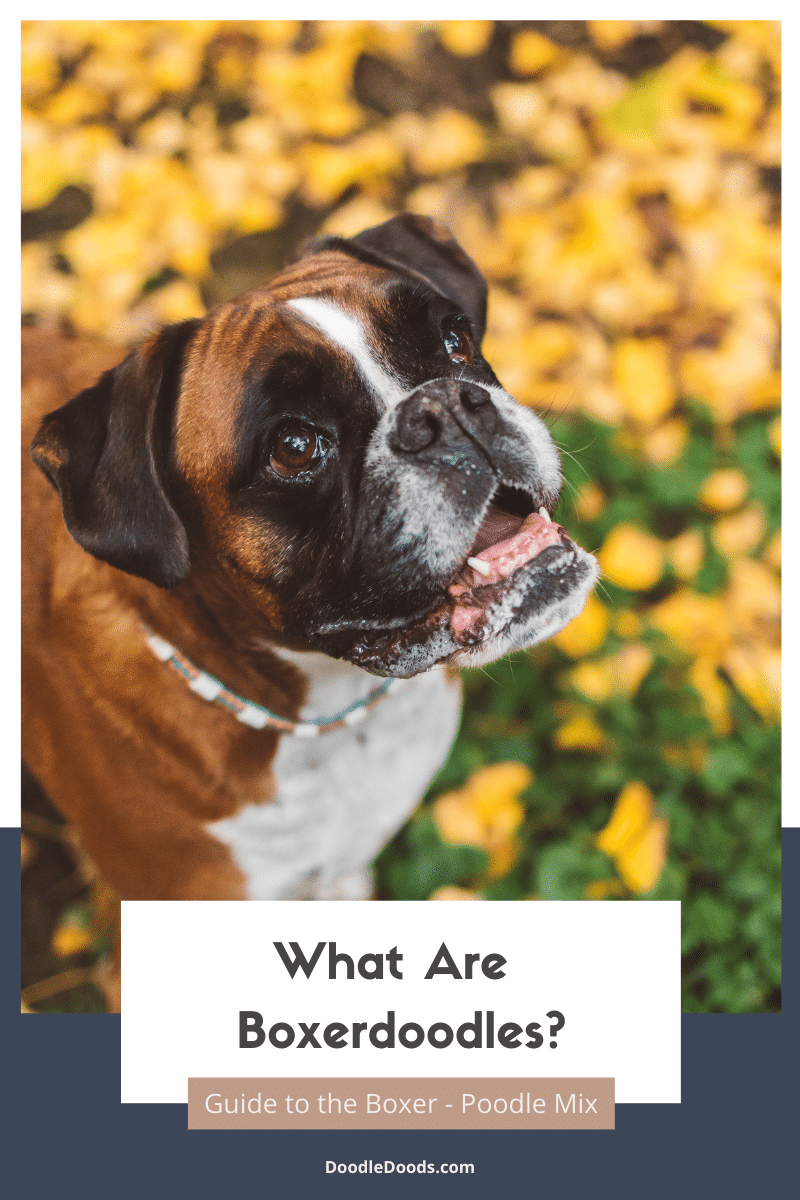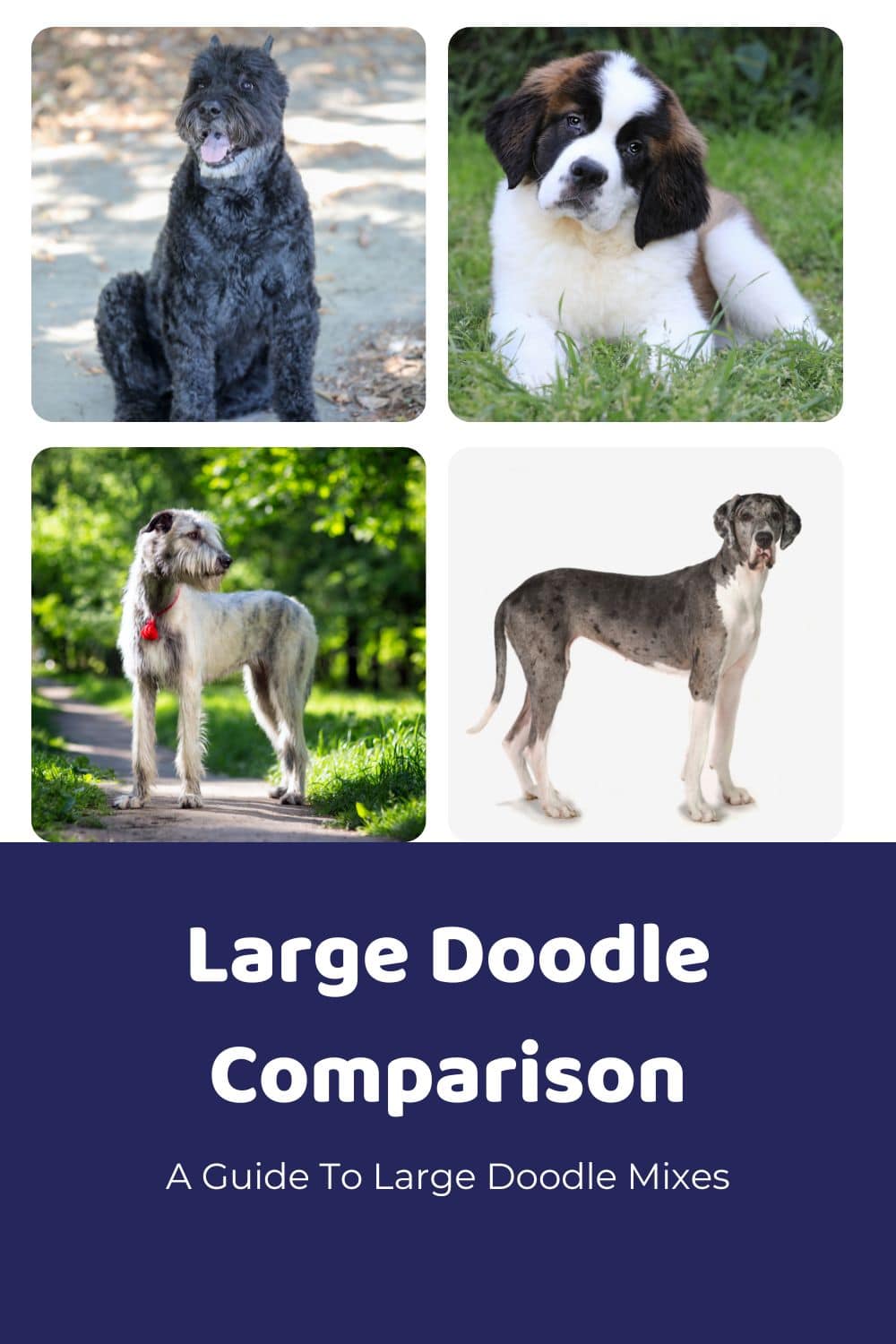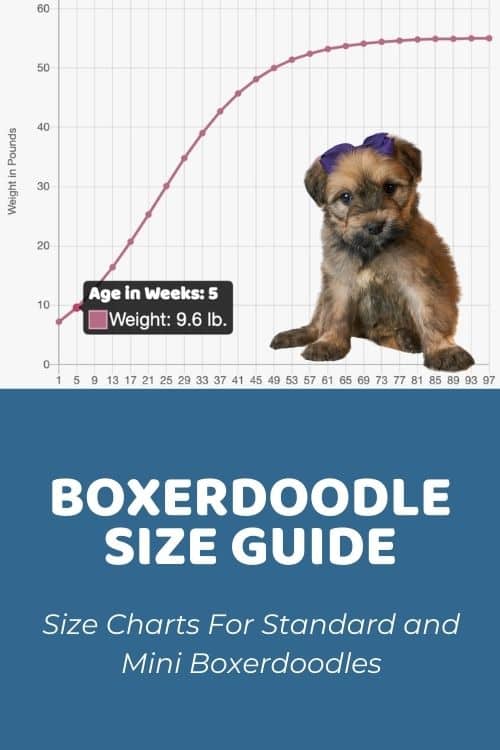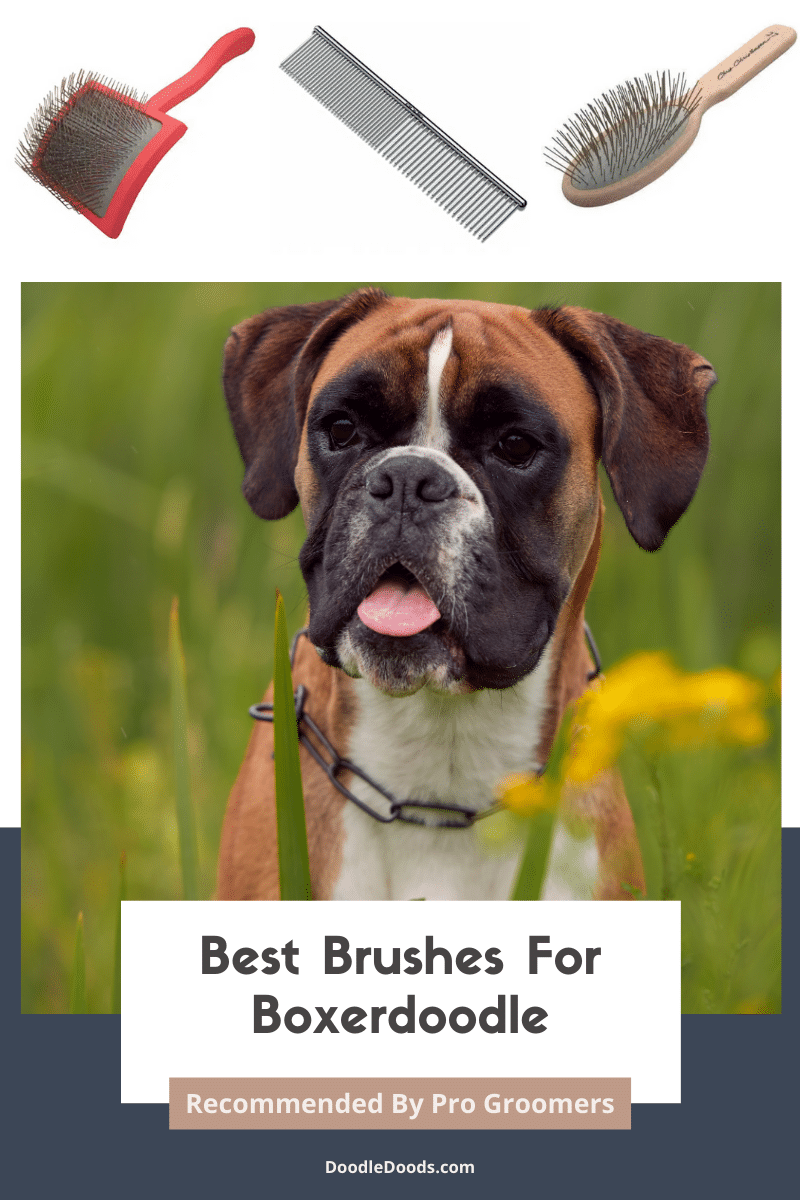The Boxerdoodle, also known as Boxerpoo, is one of the lesser known Poodle mixes. Nonetheless, these Doods are absolutely adorable and have the most wonderful temperaments! If you’re considering getting a lil’ Boxerdoodle or you’d just like to learn about this rather rare hybrid cross, then you’ve come to the right place. In this guide, we’ll cover everything from their personality to physical appearance, finishing with their exercise and grooming requirements.
Table of Contents
- What is a Boxerdoodle?
- Boxerdoodle Physical Appearance
- Boxerdoodle Pictures (Puppy & Adult)
- Boxerdoodle Size
- Boxerdoodle Variations & Generations
- Boxerdoodle Personality & Temperament
- Boxerdoodle Health & Lifespan
- Boxerdoodle Exercise & Training
- Boxerdoodle Coat & Grooming
- Where Can You Get Boxerdoodle Puppies?
- Boxerdoodle 101: Frequently Asked Questions
What is a Boxerdoodle?
The Boxerdoodle is a hybrid cross between the fiercely loyal Boxer and the hypoallergenic Poodle. Just like their purebred parents, Boxerdoodles are highly intelligent, playful, and active pups that enjoy doing all sorts of fun activities with their human parents.
Although both Boxers and Poodles are one of the most well-known purebred dogs out there, the Boxerdoodle hasn’t been around that much just yet. However, as with any other ‘designer breed’ and Poodle mix, we can expect Boxerdoodles also to become more and more popular over the upcoming years.
And just like with other Poodle mixes, there are different sizes of Boxerdoodles that one could produce. As the Poodle comes in three sizes – Standard, Miniature, and Toy – the options are almost endless.
For the Boxerdoodle mix, the most common sizes used are either Standard or Miniature Poodles. The former resulting in a large-sized Dood, and the latter variation producing smaller fun-sized Mini Boxerdoodles.
All in all, the Boxer-Poodle mix is for sure one of the up and coming Poodle mixes, and we can certainly understand why. If you’re keen on learning more about these precious pals, then below you’ll learn everything you might want to know about them!
Boxerdoodle Physical Appearance
Color
The Boxerdoodle can come in so many beautiful coat colors and patterns, it’s hard to keep track of them all! After all, as they have two very different purebred parents in their lineage, the outcome could vary significantly – it all boils down to their genetics.
Most commonly, Boxerdoodles come in various shades of browns. However, there are also other possible options, such as black, tan, fawn, red, gray, cream, white, gray, liver, and cream. You may also recognize them by their beautiful bi-color and brindle coat patterns.
Coat, Shedding, & Hypoallergenic Level
The great thing about Boxerdoodles is that they’re always single-coated dogs. That’s because the Poodle, a notoriously hypoallergenic dog, has a single layer of tight and textured curls. Meanwhile, Boxers have a single coat of short and sleek hair that doesn’t shed that much, either.
Again, the outcome may vary, as Boxers and Poodles have very different coat types. Some Boxerdoodles inherit Poodle-inspired curls, whereas others inherit a more relaxed wave that combines the two coat types. There’s also a possibility of some Boxerdoodles inheriting straight hair from their purebred Boxer parents.

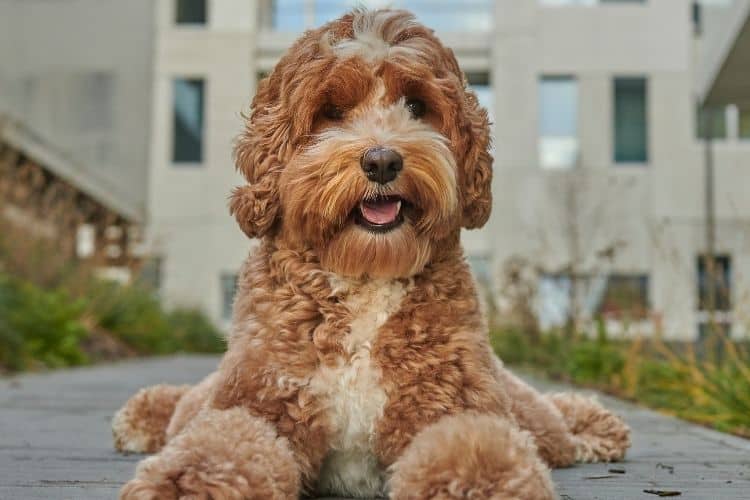
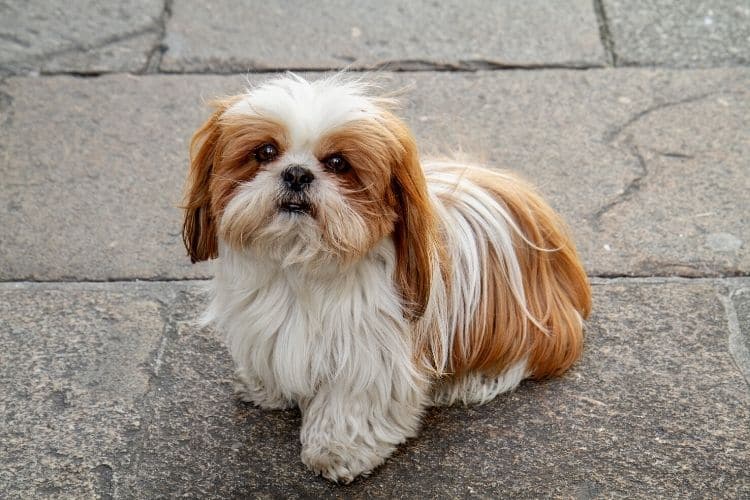
All in all, Boxerdoodles tend to be rather low-shedding dogs, making them suitable even for people with allergies. Not to mention, there won’t be much shedding present, so you won’t have to constantly clean up the loose dog hair from your clothes, furniture, or floors.
Nonetheless, keep in mind that there’s no such thing as a 100% hypoallergenic dog. There’s a common misconception that dog hair is what causes allergies in humans. However, it’s actually the protein particles found in dog saliva, dander, and urine that trigger those allergies. Of course, as dogs tend to lick themselves and their fur is the perfect place for the saliva and dander particles to settle into, loose dog hair will most certainly trigger much stronger allergic reactions.
Boxerdoodle Pictures (Puppy & Adult)
Be prepared to swoon over this absolute cuteness overload:
| Photo Link | |
| Black and White Boxerdoodle | @chartheboxerdoodle |
| Black Boxerdoodle | @zoey_boxerdoodle |
| Apricot Boxerdoodle | @dallasthedoood |
Boxerdoodle Size
In order for us to gain a better understanding of the Boxerdoodle’s size, we must first learn about their heritage. The purebred Boxer is a muscular and stocky dog that can weigh up to 80 pounds. Females tend to be slightly smaller, so the average Boxer weight ranges between 50 and 80 pounds. They usually stand about 21.5 to 25 inches tall at the shoulder.
The Poodle, on the other hand, comes in three different sizes. The largest of them, Standard Poodle, has an average weight of 38 to 80 pounds and they usually measure in at 24 to 27 inches at the shoulder.
Then there are Miniature Poodles that usually weigh between 10 to 20 pounds as full-grown dogs, with an average height of 10 to 15 inches. And finally, the smallest of them all is the Toy Poodle with a weight ranging from 4 to 12 pounds, and a height of just up to 10 inches.
Currently, as the Boxerdoodle is such a rare and new Poodle mix, they are almost always crossed with either Standard or Miniature Poodles. However, in the future we can expect to see more of the Toy Boxerdoodles emerging as well.
So, how big will a Boxerdoodle get? Here’s a helpful Boxerdoodle size chart:
| Mini Boxerdoodle | Standard Boxerdoodle | |
| Weight | 20-50 pounds | 40-70 pounds |
| Height* | 12-20 inches | 21-27 inches |
| When Full-Grown? | 11-13 months | 12.5-16 months |
* Keep in mind that a dog’s height is measured from their withers – that’s the highest part of their shoulder blades.
As we learned from the Boxerdoodle size chart above, Standard Boxerdoodles are quite similar in size to both purebred Boxers and Standard Poodles. A Standard Boxerdoodle can weigh anywhere from 40 to 70 pounds, with an average height of 21 to 27 inches. It’s also common for female Boxerdoodles to be slightly smaller than their male counterparts.
In contrast, the smaller Mini Boxerdoodle weighs in at 20 to 50 pounds and can grow up to 12 to 20 inches tall at the shoulder. Some larger Mini Boxerdoodles can weigh as much as smaller Standard Boxerdoodles. This is usually down to their genetics and generation – both of which we’ll discuss in the next section.
Boxerdoodle Variations & Generations
Another important thing to note with hybrid breeds is that there are various ways to breed them. With Doodles and other crossbreeds, this is called a generation. Basically, generations tell us how a litter of puppies were bred. It also gives us rough estimates about the genetic makeup.
You may have even heard about first-generation Boxerdoodles or first-generation backcross Boxerdoodles. But what do they mean exactly? Here’s a helpful chart explaining it all:
| 1st Parent | 2nd Parent | % Boxer* | % Poodle* | |
| F1 Boxerdoodle (first-generation) | Boxer | Poodle | 50% | 50% |
| F1B Boxerdoodle (first-generation backcross) | F1 Boxerdoodle | Poodle | 25% | 75% |
| F1BB Boxerdoodle (first-generation backcross backcross) | F1B Boxerdoodle | Poodle | 12.5% | 87.5% |
| F2 Boxerdoodle (second-generation) | F1 Boxerdoodle | F1 Boxerdoodle | 50% | 50% |
| F2B Boxerdoodle (second-generation backcross) | F1 Boxerdoodle | F1B Boxerdoodle | 37.5% | 62.5% |
| F2B Boxerdoodle (alternate cross) | F2 Boxerdoodle | Poodle | 25% | 75% |
| F3 / Multigen Boxerdoodle | F1B Boxerdoodle or higher | F1B Boxerdoodle or higher | Varies | Varies |
*These are generic calculations only – genetics are rarely mathematically accurate.

As you can see above, with generations, we can achieve much more control over the puppies size, coat type, and other characteristics. For instance, if a breeder’s goal is to produce smaller Mini Boxerdoodles, it would be wise to opt for breeding backcross generations like the F1b, F1bb, or F2b Boxerdoodle, as most of their genetics tend to come from the Poodle.
Still, as the Boxerdoodle is such a new crossbreed as of now, they’re most commonly bred as either first-generation or first-generation backcross Boxerdoodles.
Boxerdoodle Personality & Temperament
Is Boxerdoodle a good family dog? Or are Boxerdoodles aggressive? What about their intelligence and activity levels? These questions are bound to pop up in your head if you’re considering expanding your family with this wonderful pooch.
As you’ve probably gotten the hint by now, Boxerdoodles combine the best traits from both of their purebred parents. Boxers are well-known for their fierce, loyal, and playful nature, whereas Poodles are almost always high energy and highly intelligent dogs.
In fact, Boxers and Poodles share many of the same personality traits, including their undivided adoration towards their humans, love for all things related to exercise, and the smarts they’ve been blessed with. In addition to that, both Poodles and Boxers tend to be very affectionate dogs and get along very well with young children.
Similarly, the Boxerdoodle is a sweet-natured, loving, super loyal, and highly intelligent Dood that loves spending time with its human family. They’re super playful and active, gladly accompanying you on long walks and hikes, and always wanting to play fetch with you. They can even be quite goofy at times, making sure that you’re always entertained. This makes the Boxerdoodle an excellent pet for singles, couples, and families.
Of course, thanks to their high levels of intelligence from both sides of their lineage, Boxerdoodles are generally easy to train and eager to please their humans. Such a winning combination, we must say!
Boxerdoodle Health & Lifespan
Another great thing about hybrid breeds, including the Boxerdoodle, is that they’re thought to be healthier than their purebred parents. That’s because of something called hybrid vigor, which indicates that crossbreeds may inherit superior qualities and a more diverse genetic makeup from their purebred parents. As a result, they’re less likely to inherit breed-specific genetic health conditions that are prevalent in either purebred Poodles or Boxers.
Nonetheless, this doesn’t mean that Doodles never experience any health issues or inherit any genetic conditions. They’re still at risk of certain illnesses that their purebred parents are prone to. So, what health problems do Boxerdoodles have?
The most common health issues on Boxerdoodles include joint problems like hip and elbow dysplasia, gastric dilation volvulus (GDV), Addison’s disease, and a heart condition common in Boxers called cardiomyopathy. They’re also at risk of eye diseases like progressive retinal atrophy (PRA) and cataracts, and also epilepsy, cancer, thyroid problems, and Cushing’s disease.
Some less serious conditions that are common in Boxerdoodles are skin problems, such as dryness, sensitivities, and allergies, but also food allergies and intolerances. As they may struggle with these sensitivities, you should keep a close eye on their overall health and wellbeing. Choosing a high-quality and nutritious dog food formula is vital, and you’ll want to avoid any artificial preservatives, filler ingredients, or flavors in the formula. Moreover, Boxerdoodles are also prone to ear infections, so proper ear hygiene is vital for these Doods.
Boxerdoodle Lifespan
In terms of their life expectancy, we can expect Boxerdoodles to live anywhere from 10 to 15 years. The purebred Boxer has an average lifespan of 10 to 12 years, whereas the Poodle usually lives between 12 to 15 years.
Even though there are many possible health conditions that Boxerdoodles could inherit from either side of their lineage, that’s not to say that they will suffer from these diseases. As long as you provide your pup with a healthy and balanced diet, plenty of exercise, and keep their stress levels at a minimum, you’re already doing so much to prevent many of these conditions.
Boxerdoodle Exercise & Training
Thanks to their highly intelligent parents, Boxerdoodles are intelligent dogs that are eager to please their human parents. If you’d like to know – are Boxerdoodles easy to train? Then yes, indeed, they are.
Nonetheless, this doesn’t mean that your Boxerpoo will train itself and you won’t have to teach them anything. Rather, you should start as early as possible, so that all of those good behaviors and skills will be much sooner acquired.
You’ll want to start with early socialization and introduce your new puppy to people of all ages, races, and also other dogs, and cats. This way, your Dood will learn from a young age how to interact with others, and how to react when they encounter new people or animals while out and about.
Another trick is to start introducing your new pup to potty training, crate training, and obedience training from an early age. Luckily, many reputable breeders already do so, but it’s your responsibility to stay consistent on this once you bring your new puppy home.
There’s also the matter of providing enough mental and physical stimulation that these highly intelligent and active dogs so desperately need. If your pup is lacking in these areas, don’t be surprised if they become bored and resort to destructive behaviors.
As Boxerdoodles are rather high energy dogs, they need at least 60 minutes of exercise each day. You can take your Dood out for long walks and runs, for playtime at the dog park, or even let them go swimming – they love it! Similarly, make sure you provide plenty of chew toys, interactive puzzle games, and other forms of enrichment methods so that your pup gets to put its brain to good use.
Get Help From True Professionals
Obviously, a lot goes into training a dog, and there’s no shame in having to ask for some help. In fact, one of our absolute favorite picks for dog owners is the Online Puppy School by Baxter & Bella. This is such an amazing program that every single pet owner can benefit from. For a one-time fee you’ll get lifetime access to countless resources, including video tutorials, articles, a live forum, check lists, and much-much more.
Boxerdoodle Coat & Grooming
If you know a little bit about Doodles, you know that they require lots and lots of grooming to stay healthy, happy, and looking fabulous. Fortunately, Boxerdoodles don’t shed much hair, so that’s one thing off your plate. However, there are quite a few other grooming activities you have to mark in your calendar.
Firstly, Boxerdoodles need to be brushed at least 3 times a week. Ideally, you’d brush them daily, as this is the easiest, most effective thing you can do to prevent knots and matted hair. This is especially crucial if your Boxerdoodle has a curly coat, as the tight and textured curls easily trap in dirt, debris, and loose dog fur, leading to matting.
Secondly, as their hair grows, sometimes insanely fast, it’s important to also have your Boxerdoodle’s hair trimmed by a professional groomer or yourself at home. In fact, as those routine trips to the groomers can become costly over time, many Doodle owners opt for grooming their Doods at home by themselves. Not only will this save you money, it’s also a great way to bond with your best pal.
Thirdly, don’t forget to regularly bathe your dog with a proper dog shampoo, stay on top of their dental hygiene routine, trim their nails weekly, and keep their ears clean and dry to prevent any ear infections. Be sure to check out the links as well, as we’ve prepared in-depth guides on all of these topics.
Where Can You Get Boxerdoodle Puppies?
If you’re now certain more than ever that the Boxerdoodle is the right choice for you, then you’re probably wanting to know how much does a Boxerdoodle cost, anyway? Like with other Poodle mixes, you can expect to pay anywhere from $1,000 and up to $4,000 for a Boxerdoodle puppy in the US.
Needless to say, it’s vital that you choose a responsible breeder that follows ethical breeding guidelines. These include extensive health and genetic testing of the breeding dogs, providing the dogs and puppies a loving home environment to thrive in, feeding them a healthy diet, and introducing them to training and socialization. All things considered, the adoption price doesn’t seem that high.
As fellow Doodle owners, we know first-hand how difficult it can be to find reputable Doodle breeders that really do put the health and wellbeing of their dogs and puppies first. For this reason, we created our very own Doodle Breeder Directory listing reputable Boxerdoodle breeders in the US, Canada, Australia, UK, Germany, and Netherlands.
Boxerdoodle 101: Frequently Asked Questions
The Boxerdoodle is a hybrid cross between the Boxer and Poodle. Sometimes also called the Boxerpoo, these dogs combine the best traits from both of their purebred parents.
Just like their parents, Boxerdoodles are super intelligent, highly energetic, playful, loyal, and affectionate companions. They make excellent companions for both singles and families alike, as they generally get along very well with children.
Boxerdoodles can weigh anywhere from 20 to 70 pounds, depending on the size of Poodle used in the mix. Larger Standard Boxerdoodles generally weigh between 40 and 70 pounds with an average height of 21 to 27 inches. The smaller Mini Boxerdoodles usually weigh about 20 to 50 pounds and stand between 12 and 20 inches tall.
Learn How to Care for Your Doodle Puppy!

Perfect for first-time Doodle parents, get ALL your questions answered, including questions new Doodle parents don’t even think to ask.
Plus, get $700 worth of Bonus Materials for FREE, including:- Doodle Parenthood Community and Support Group ($190 value)
- Doodle Puppy Growth Tracker ($20 value)
- EMERGENCY Cheatsheet: When To Call The Vet Immediately ($50 value)
- HELP! Button ($145 value)
- And SO MUCH MORE!

